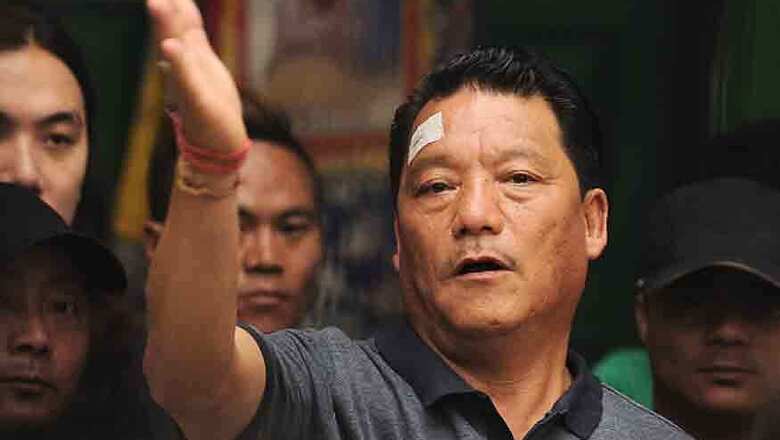
views
The news of Bimal Gurung’s possible return, after hiding for nearly two years, to Darjeeling spread like wildfire on Thursday.
Local television channels flashed the news, phones buzzed with WhatsApp messages, while the state police reacted by detaining two of his supporters from the Bagdogra airport.
Absconding, since the state government brought numerous criminal cases against him in connection with the 104-day agitation between July and September 2017 that left 13 dead in the ensuing violence, Gurung had been the unchallenged ruler of Darjeeling from 2008 to 2017.
His absence, the BJP argues, allowed the Trinamool Congress to engineer a split in the party he founded and since then, his close aide Binay Tamang has sided with the TMC.
In many ways, Darjeeling is the final conquest for Mamata Banerjee in the state. For the leader who has Prime Ministerial ambitions, this remains a seat she has never won.
Even in the 2016 Assembly election, of the six seats that constitute Darjeeling’s Lok Sabha seat, the Banerjee-led Trinamool Congress won only one, and even that was in an adjacent district in the plains.
Key to all of this is Gurung. And BJP’s Lok Sabha candidate Raju Bista (supported by Gurung’s faction) admitted that his campaigning in the hills would be a “major victory”.
For the BJP, meanwhile, the seat is equally important. With the Gorkha Janmukti Morcha (GJM)’s support, 2009 saw former cabinet minister Jaswant Sinha being elected as MP, while in 2014, Union Minister SS Ahluwalia was voted in.
However, Ahluwalia’s absence during the 104-day agitation, combined with his purported comments about residents being ‘born in Nepal’, have left the BJP vastly unpopular.
The origins of Bimal Gurung
In 1979, the Gorkha National Liberation Front (GNLF), led by Subash Ghising launched a struggle for self-determination and, at the time, didn’t rule out full secession from India if self-rule, separate from West Bengal, wasn’t conceded.
The decade-long struggle eventually led to the formation of the Darjeeling Gorkha Hill Council (DGHC) in 1988, aimed at ensuring territorial autonomy over three sub-divisions in the district with Ghising at its helm.
Born to tea garden workers, Gurung did menial jobs while growing up to help is family until joining the armed struggle by the GNLF in 1986 and becoming a member of the Gorkha Volunteers Cell as a 22-year-old.
Meanwhile, the DGHC was marred by allegations of mismanagement and corruption and it was eventually the issue of the Sixth Schedule — a constitutional provision for fast development of tribal areas by setting up autonomous regional councils authorised to take legislative decisions independently — that eventually acted as the catalyst for Gurung’s rise.
He was expelled from the GNLF on October 7, 2007, which in turn led him to form the GJM.
In his book, “Gorkhaland: Crisis of Statehood”, journalist Romit Bagchi argues that the “singular quality” that allowed Gurung to replace Ghising’s leadership was "his invincible loyalty to the paramount cause of the community" — the demand for statehood.
Gurung argued, at the time, that the Sixth Schedule was simply a ploy to weaken the demand for autonomy by the CPI(M).
The winter session of Parliament was scheduled to begin from November and the CPI(M), through its minister Ashok Bhattacharjee and Rajya Sabha MP Suraj Pathak issued a statement publicising that the Sixth Schedule bill would be placed and passed in the same session.
On the day the session began, the newly formed GJM took to the streets, burning copies of the memorandum settlements made between the state government, Union government and Subash Ghising, the GNLF chief at the time.
A team of GJM leaders would go on to meet Sushma Swaraj, the chairperson of the Parliamentary Standing Committee, and leader of opposition LK Advani.
Eventually, the Buddhadeb Bhattacharjee-led CPI(M) government found itself in a fix over the bill after the BJP refused to back the legislation, with Advani reminding home minister Shivraj Patil that cooperation couldn’t be expected at a time when Congress president Sonia Gandhi had described the saffron party as ‘merchants of death’ in Gujarat.
Bhattacharjee, it was widely reported, had rushed to Advani’s residence to try and seek the BJP’s support.
In February 2008, Ghisingh faced what was arguably the greatest humiliation in his political career when he wasn’t allowed to return to the hills following a visit to Delhi as the GJM blocked all entry points to the hills. Gurung had effectively established himself as the political kingpin in the hills.
The uneasy truce and the TMC challenge
With the Trinamool Congress ending the 34-year-old rule of the Left Front in 2011, Gurung found an opportunity to enter into a truce with the government by signing the Gorkhaland Territorial Administration (GTA), setting up a second regional autonomy body in the area with himself as its helm. But the relationship between Gurung and Mamata Banerjee remained uneasy.
Writing in 2009, Bagchi predicted that “people would not accept a mellowed Bimal Gurung who speaks the voice of reason and restraint” and the GJM chief soon found his support eroding.
In the 2016 Assembly election, although he proved victorious, Banerjee’s TMC had made significant inroads. Senior party leaders, including GTA chairperson Pradeep Pradhan, left his fold and joined the TMC.
Banerjee’s tactics were described by Gurung as one of “divide-and-rule” and in the run-up to the Assembly poll, she had announced the formation of different development boards for communities in Darjeeling, like the Lepcha Development Board and the Tamang Development Board.
“This effectively weakened the hold Gurung had over Gorkhas as one community and even now, the Lepcha and Tamang communities, for instance, are firmly with the TMC,” said a GJM leader with the Gurung faction.
Perhaps, unsurprisingly, Gurung returned the politics of confrontation that he knew. He relaunched the Gorkhaland demand while simultaneously filing a plea in the Supreme Court challenging the West Bengal government's refusal to transfer administrative power and various subjects to the GTA, in spite of a tripartite agreement that was reached within the state and Union governments in 2011.
In June 2017, an attempt to make Bengali compulsory in schools (clarified later to be optional in the hills) led to a resurgence of agitation by the GJM.
On June 15, police conducted raids at the GJM leader’s residence, leading him to call an indefinite strike in the hills.
The protests that started then would eventually see Gurung go into a hiding. But this was the opportunity that Banerjee needed, alleged BJP leaders.
“What happened in Gurung’s absence was two-fold. First, there was a vacuum in leadership. Binay (Tamang) is no Gurung. He doesn’t hold the same kind of hold over voters and can never influence polls singlehandedly. Secondly, the GNLF which had been weakening was suddenly the big brother in the equation,” said a BJP leader.
What Gurung’s return could mean
Across Darjeeling, posters from the agitation in 2017 can still be found, some torn off by the state administration, others worn by the elements.
However, support for Gurung hasn’t faded and some argued that his absence had just made him more of a folk hero.
Shakeel Shuba, who lives minutes from Gurung’s residence in Darjeeling, said, “It is all forgiven now. There is no option for us. On the one hand, we have the BJP, who we gave a chance for 10 years, and on the other hand, we have the TMC that will never give us statehood. If Gurung returns, then we at least ave a leader who we have known and can trust.”
Gurung, who has been issuing video statements while putting his weight behind the BJP, will be key. In spite of Tamang’s claims that “Gurung’s returning to the hills wouldn’t matter”, a senior TMC MP said, “This is an election like no other in the hills. So far, neither candidate has spoken about Gorkhaland. The TMC will not speak about it because that is not our stand and the BJP can’t because it has been in power since 2009 in the seat and in power in the Centre for five years.”
Gurung, on the other, the TMC leader argued, “is the very personification of that demand.” His return, he added, “could change everything”.


















Comments
0 comment